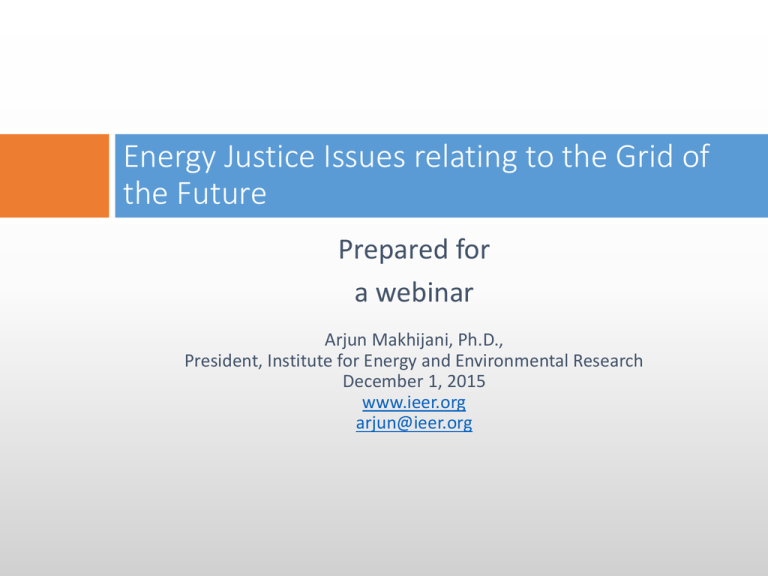Energy Justice Issues relating to the Grid of the Future Prepared for
advertisement

Energy Justice Issues relating to the Grid of the Future Prepared for a webinar Arjun Makhijani, Ph.D., President, Institute for Energy and Environmental Research December 1, 2015 www.ieer.org arjun@ieer.org Today’s energy system is wasteful Example 1: Thermal generation: ~30% efficiency Example 2: Lighting ~ 2.5% to 20% of electricity to light Today’s energy system is wasteful: Slide 2 Example 3: Typical gasoline vehicle ~80 percent waste Example 4: Leaky buildings IMPOSSIBE CHOICES: RENT, MEDICINE OR HEAT HIGH PUBLIC SHELTER COSTS HIGH HEALTH COSTS 4 LOW-INCOME HOMES ARE RELATIVELY INEFFICIENT Primary energy use per unit area in Maryland households, 2010 120,000 100,000 Btu / sq. ft. 80,000 Average household 60,000 MEAP household 40,000 20,000 0 Overall energy Heating only LOW-INCOME HOUSEHOLDS HAVE NOT HAD ACCESS TO SOLAR ENERGY APS, CSI, and NJCEP percentage of installations by income level and year $0 - 39,999 $40,000 - $89,999 APS $90,000+ CSI NJCEP 100% 15.48% 90% 19.25% 10.51% 10.83% 15.04% 29.89% 26.18% 25.58% 28.13% 31.43% 25.45% 34.02% 80% Percentage of installations 28.21% 34.05% 42.95% 70% 60% 50% 83.03% 78.75% 83.91% 77.25% 74.08% 40% 68.21% 66.86% 65.51% 70.58% 67.36% 65.21% 30% 61.76% 70.74% 62.06% 55.86% 20% 10% 0% 6.66% 5.77% 7.27% 6.47% 5.26% 3.36% 3.25% 4.51% 5.57% 3.84% 1.19% 4.19% 3.91% 6.28% 3.80% 2009 2010 2011 2012 2013 YTD 2009 2010 2011 2012 2013 YTD 2009 2010 2011 2012 2013 YTD 6 WHAT ABOUT ENERGY ASSISTANCE PROGRAMS? AID HELPS A LOT STRUCTURAL PROBLEMS REMAIN + TRANSPORTATI ON NOT ADDRESSED LIMIT BILLS TO 6% OF INCOME + UNIVERSAL SOLAR ACCESS + EFFICIENCY = CLIMATE PROTECTION + STRUCTURAL BILL REDUCTION + STRUCTURAL ASSISTANCE COST REDUCTION Photo: Lake City Village low-income housing, Seattle, Washington. Photo courtesy of SolarWorld www.solarworld.com 8 The future grid: some relevant essentials • Variable sources: wind and solar (Maryland and ~>10x as much as needed even with economic growth) • Solar is the main distributed resource • Resilience + low emissions require distributed solar + distributed storage + microgrids + demand response = nested smart grid • Electric vehicles (private and public) and vehicle-to-grid technology 9 SOME CURRENT AND SMART GRID CHARACTERISTICS Current Grid Smart Grid Communications None or one-way; typically not real-time Customer Limited interaction Metering Electromechanical Two-way, realtime Comments Customer needs smart devices and real-time information Extensive Digital (enabling Affordable bills will real-time pricing require real time and net metering) control of consumption and ownership of energy production 10 Revenue streams/bill reduction potential • Generate solar energy • Increase efficiency • Participate in demand response • Control consumption to minimize bills • Transition to electric vehicles (low-maintenance and low fuel cost) • Provide services to the grid, including via V2G and local storage ownership 11 ENERGY JUSTICE AND GOTF • Universal solar access and universal internet access • Once Affordable Energy Program in place, assistance can be in the form of investment: smart appliances + smart devices (tablets, phones, etc.) to optimize bills • Large collateral benefits of internet access – education, work, economic opportunity • Electric vehicles: lower fuel and maintenance cost + V2G revenue potential • Infrastructure in low income areas: Building community solar + electric vehicle charging + distributed stationary storage • Financing: PACE, Green Bank, On-bill financing 12 AFFORDABLE GRID FOR ALL FOR MORE INFORMATION www.ieer.org Energy Justice slides based on http://ieer.org/resource/energy-issues/energy-justice-marylands-residential/ Arjun Makhijani Institute for Energy and Environmental Research 6935 Laurel Avenue, Suite 201 Takoma Park, Maryland 20912 U.S.A. 301-270-5500 14

